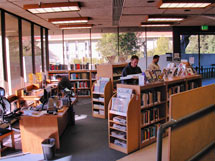
Handy Links
SLAC News Center
SLAC Today
- Subscribe
- Archives: Feb 2006-May 20, 2011
- Archives: May 23, 2011 and later
- Submit Feedback or Story Ideas
- About SLAC Today
SLAC News
Lab News
- Interactions
- Lightsources.org
- ILC NewsLine
- Int'l Science Grid This Week
- Fermilab Today
- Berkeley Lab News
- @brookhaven TODAY
- DOE Pulse
- CERN Courier
- DESY inForm
- US / LHC
SLAC Links
- Emergency
- Safety
- Policy Repository
- Site Entry Form

- Site Maps
- M & O Review
- Computing Status & Calendar
- SLAC Colloquium
- SLACspeak
- SLACspace
- SLAC Logo
- Café Menu
- Flea Market
- Web E-mail
- Marguerite Shuttle
- Discount Commuter Passes
-
Award Reporting Form
- SPIRES
- SciDoc
- Activity Groups
- Library
Stanford
Around the Bay
The Next SLAC Research Library
Something old, something new, something borrowed…
As you know, SLAC is working hard to prioritize and improve its current and future support infrastructure and services. While the current library budget has been reduced, we in the SLAC Research Library wanted to communicate that we are substantially increasing journal acquisitions, preparing a new library model for SLAC, and also discontinuing centralized control of books purchased for departmental or individual use. The SLAC director and associate lab directors reached these decisions after considering both specific recommendations for the library and the competing priorities for SLAC indirect funding.
The SLAC Research Library will undergo another transformation when it moves from its current location in the lobby of Building 50 to one of the new buildings being constructed at the laboratory. The new library will be based on the "Information Commons" model and will include reference librarian services, compact shelving for book collections, and collaborative work areas in a comfortable, café-style environment.
The future SLAC Research Library will emphasize electronic access to books, journals, standards and databases to keep up with the continually changing and expanding information universe. As a coordinate library of the Stanford University Library system, and in collaboration with the physics, engineering and chemistry libraries on campus, the SLAC Research Library currently offers electronic access to a tremendous number of journals, databases and books. Many journal backfiles have been recently purchased, providing a wider range of articles that can be searched, read, printed or saved as PDF files. The library will continue to purchase and provide access to more online journals and resources in preparation for our move to a primarily electronic library.
The library will no longer be handling the paperwork for, nor cataloging, books and standards purchased exclusively for individual and departmental use—so called "non-institutional" books. We are happy to help you find a vendor, or conduct a search to make sure you purchase the latest edition at the best price. Books for individual or departmental use can easily be purchased following standard SLAC procurement procedures.
Books are an important part of any library. The SLAC Research Library will be not only a place for books, but a source for books. For those more comfortable with the look and feel of a traditional library, a large part of our collection—well over 20,000 books—will be removed from storage and placed in space-saving, high-volume compact shelving. In addition to our large, unique collection of high-energy physics books, the SLAC Research Library will increase its holdings of accelerator, astroparticle physics, and photon and materials science books. The library has been allocated $20,000 for the 2010 fiscal year for purchase of books that are of importance to laboratory research and expected to be in heavy demand.
Many books are now available online through our partnership with Stanford University Libraries & Academic Information Resources. A large number of e-books and proceedings available to you have not been cataloged by Stanford or SLAC and are often hidden in e-book databases such as Springer Online, Safari Tech Books, Knovel Engineering Books, and IEEE Xplore, to name just a few. The SLAC library staff can help you tap into these wonderful resources.
We will continue to borrow books on your behalf from the campus libraries, making once-or-twice-a-week trips to the university to pick up books and other materials for your convenience. We will also continue to rely on our partnership with the University of California, State University Libraries and other Department of Energy national laboratories to provide books and materials to meet your research and administrative needs. We can also request books and materials from academic libraries across the United States, Canada and Europe—an important service for today’s global scientific collaborations.
A new SLAC Research Library built on the electronic model essentially creates libraries within a library, so that books, journals and databases such as Web of Science, ChemNetBase, and the SPIE Digital Library, to mention a few, can be accessed from your office or home by logging into the SLAC network.
The library research staff will continue to deliver the more-difficult-to-find articles, standards and other documents by e-mail or in person, will provide complex expert reference research projects and complex bibliographic verification, and will be able to help library users navigate the sometimes arcane interfaces of electronic journals, databases and standards collections.
The overall mission of the SLAC Research Library is to provide and help you find the information you need to conduct your work quickly, conveniently, accurately and with the least amount of effort on your part. Contact us at x2411 or library@slac.stanford.edu.
—Ann Redfield
SLAC Today, April 13, 2010
